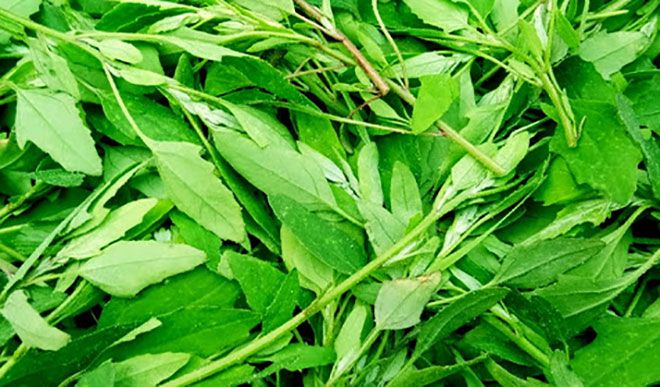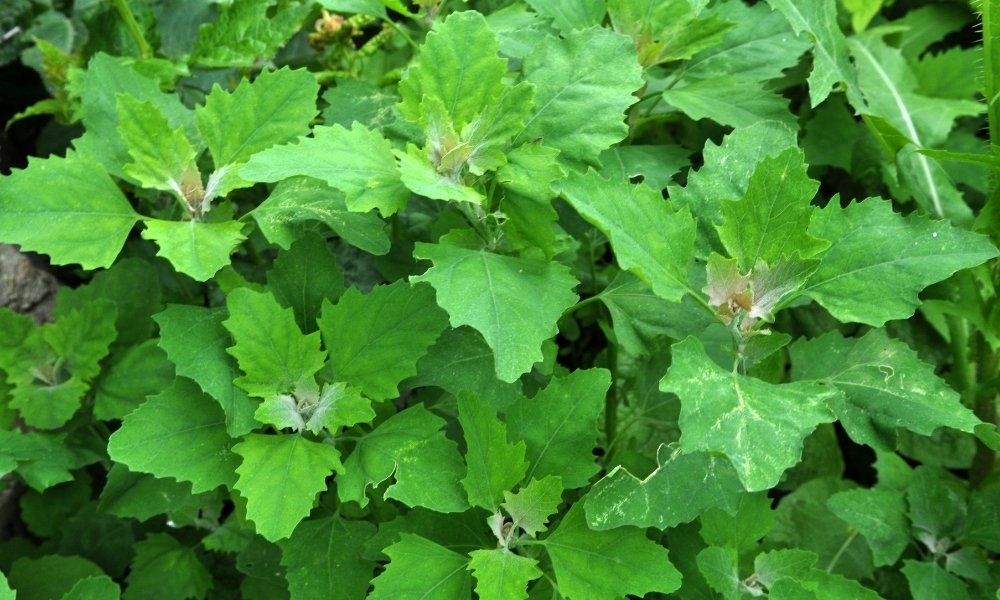प्याज की खेती एक महत्वपूर्ण कृषि प्रक� ...
Bathua (Chenopodium album) is a nutritious leafy vegetable commonly grown during the winter season in many regions. Its leaves are rich in vitamins A and C, along with calcium. Bathua is considered a low-cost, high-profit crop for farmers as it requires minimal care. Let’s explore how Bathua is cultivated.
बथुआ (Chenopodium album) एक पोषक तत्वों से भरपूर साग है जो सर्दियों के मौसम में अधिकतर क्षेत्रों में उगाया जाता है। बथुआ की पत्तियाँ विटामिन ए, सी, और कैल्शियम से भरपूर होती हैं। इसका अनोखा स्वाद और विविधता इसे विभिन्न व्यंजनों में पसंदीदा बनाते हैं, जैसे साग और पराठे। यह फसल किसानों के लिए कम लागत और अधिक लाभ देने वाली मानी जाती है, क्योंकि इसे बहुत अधिक देखभाल की आवश्यकता नहीं होती। आइए जानते हैं बथुआ की खेती कैसे की जाती है?
बथुआ ठंडी जलवायु में अच्छी तरह से उगता है, खासकर सर्दियों के मौसम में। इसे 15-25 डिग्री सेल्सियस तापमान में आसानी से उगाया जा सकता है। हालांकि बथुआ को विभिन्न प्रकार की मिट्टी में उगाया जा सकता है, लेकिन हल्की दोमट और जल निकासी वाली मिट्टी इसके लिए सबसे उपयुक्त होती है।

बथुआ की बुवाई का सबसे उपयुक्त समय अक्टूबर से नवंबर के बीच होता है। हालांकि, इसे कुछ क्षेत्रों में जनवरी तक भी बोया जा सकता है, लेकिन इसके लिए तापमान और जलवायु का ध्यान रखना आवश्यक है।
बथुआ की खेती के लिए प्रति हेक्टेयर 4-5 किलोग्राम बीज की आवश्यकता होती है। बुवाई के लिए खेत की गहरी जुताई की जाती है और उसके बाद बीजों को खेत में बिखेर कर हल्की मिट्टी डाल दी जाती है। बीजों को 1-2 सेमी गहराई में बोना चाहिए, ताकि उनके अंकुरण में कोई समस्या न हो।

बथुआ की खेती में जैविक खाद का प्रयोग करना अधिक लाभदायक होता है। अगर रासायनिक उर्वरक का प्रयोग किया जा रहा है तो प्रति हेक्टेयर 40-50 किलोग्राम नाइट्रोजन और 30-40 किलोग्राम फॉस्फोरस देना चाहिए। बुवाई से पहले 2-3 टन गोबर की खाद या कम्पोस्ट भी मिट्टी में मिलाना फायदेमंद रहता है।
बथुआ की फसल के लिए पानी की बहुत अधिक आवश्यकता नहीं होती। पहली सिंचाई बुवाई के तुरंत बाद की जाती है और उसके बाद 15-20 दिन के अंतराल पर सिंचाई की जानी चाहिए। ध्यान रखें कि खेत में जल जमाव न हो, क्योंकि यह पौधों की जड़ों को नुकसान पहुंचा सकता है।
यह भी पढ़ें: धनिया की खेती | पालक की खेती
बथुआ की खेती में निराई-गुड़ाई का विशेष ध्यान रखना आवश्यक है, ताकि फसल को खरपतवारों से बचाया जा सके। बुवाई के 20-25 दिन बाद पहली निराई करनी चाहिए। इसके बाद हर 15-20 दिन में खेत की निराई करते रहें।
बथुआ की पत्तियों की कटाई बुवाई के 45-50 दिन बाद की जा सकती है। फसल की कटाई हाथ से की जाती है। कटाई के बाद पत्तियों को धूप में सुखाकर उन्हें उपयोग के लिए तैयार किया जा सकता है। बथुआ की उपज प्रति हेक्टेयर 80-100 क्विंटल तक हो सकती है।

बथुआ की खेती कम लागत और अधिक मुनाफे वाली होती है। इसके पौधे न केवल साग के रूप में उपयोग किए जाते हैं, बल्कि इसके बीज भी पोषक तत्वों से भरपूर होते हैं। इसके साथ ही बथुआ से कई औषधीय उत्पाद भी बनाए जाते हैं, जिससे इसकी मांग बाजार में बनी रहती है।
बथुआ की खेती एक सरल और फायदेमंद प्रक्रिया है। अगर आप कम लागत में ज्यादा लाभ कमाना चाहते हैं तो बथुआ की खेती एक उत्तम विकल्प हो सकता है। सही समय पर बुवाई, उचित सिंचाई और नियमित निराई-गुड़ाई करके आप इस फसल से अच्छा उत्पादन और लाभ प्राप्त कर सकते हैं|
कृषि से संबंधित वीडियो देखने के लिए यहाँ क्लिक करें: YouTube
Bathua thrives well in cold climates, especially during winter. It grows best in temperatures ranging from 15°C to 25°C. Though Bathua can be cultivated in various types of soil, light loamy and well-drained soils are the most suitable for its growth.
The ideal time for sowing Bathua is between October and November. In some regions, it can also be sown until January, but climate and temperature should be carefully considered for optimal results.
For Bathua cultivation, 4-5 kg of seeds are required per hectare. The field is plowed deeply, and the seeds are scattered evenly, followed by a light covering of soil. Seeds should be sown at a depth of 1-2 cm to ensure proper germination.
Using organic manure in Bathua farming yields better results. However, if chemical fertilizers are being used, 40-50 kg of nitrogen and 30-40 kg of phosphorus per hectare should be applied. It’s also beneficial to mix 2-3 tons of farmyard manure or compost into the soil before sowing.
Bathua doesn't require much water. The first irrigation should be done right after sowing, followed by irrigation at 15-20 day intervals. Be careful to avoid waterlogging, as it can damage the roots of the plants.
Weeding is crucial in Bathua farming to protect the crop from unwanted plants. The first weeding should be done 20-25 days after sowing, and subsequent weeding every 15-20 days will help the crop grow better.
The leaves of Bathua can be harvested 45-50 days after sowing. Harvesting is done manually. After cutting, the leaves are dried in sunlight before being prepared for consumption or sale. The crop yield can be around 80-100 quintals per hectare.
Bathua farming is a low-cost, high-profit venture. Its leaves are not only used as a leafy vegetable, but its seeds are also highly nutritious. Additionally, Bathua has various medicinal uses, which maintain its demand in the market.
Bathua cultivation is a simple and profitable farming option. If you aim to earn good profits with minimal investment, Bathua is an excellent choice. With timely sowing, proper irrigation, and regular weeding, you can achieve high production and profits from this crop.
0
0
प्याज की खेती एक महत्वपूर्ण कृषि प्रक� ...
Potatoes are a versatile and widely consumed root vegetable, rich in nutrients such as carbohydrates ...
Garlic is a widely used spice and medicinal plant cultivated for centuries. It is known for its spic ...
Coriander farming offers lucrative returns for farmers due to its high demand in the culinary and me ...
September is an ideal month for sowing various vegetables that can be harvested in the cooler months ...
Ghiya, also known as bottle gourd, is a popular and nutritious vegetable grown in many parts of Indi ...
Tomato farming is a popular agricultural practice due to the high demand for tomatoes worldwide. It ...
खीरा की खेती एक लाभदायक कृषि व्यवसाय ह ...
अक्टूबर का महीना शरद ऋतु का प्रारंभ हो ...
Beetroot cultivation is a profitable agricultural venture that involves growing a nutritious root ve ...
Tauri, also known as Ridge Gourd, is a popular vegetable cultivated in many parts of Asia. It is hig ...
Eggplant, also known as Brinjal or Solanum melongena, is a widely cultivated vegetable in India, pri ...
Pea (Pisum sativum) is one of the major legume crops in India, used both as a vegetable and a pulse. ...
Chickpea (Cicer arietinum) is an important pulse crop, particularly grown in India. Its cultivation ...
Sem, also known as ‘Beans,’ is a significant leguminous crop that is not only rich in nutrition ...
Lentils (Lens culinaris) are a valuable pulse crop grown in India during the Rabi season. Known for ...
The winter season is an excellent time for farmers, especially for cultivating vegetables. Vegetable ...
After harvesting rice, it is important for farmers to plan for the next crop. This is the time when ...
December marks the beginning of winter, making it an ideal time for vegetable farming. This season p ...
Red spinach, known as "लाल साग" in Hindi, is a nutrient-rich leafy vegetable that stands ...
There’s something special about enjoying freshly grown vegetables from your own home. It’s not o ...
February is an important time for agriculture, especially for farmers who are preparing for rabi and ...
Fruit drop or lack of fruiting in bottle gourd plants is a common issue, whether they are grown in s ...